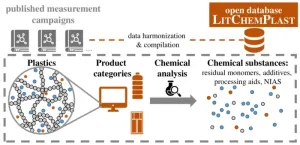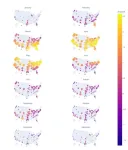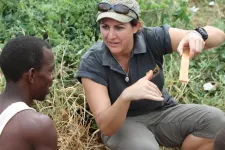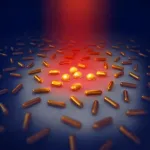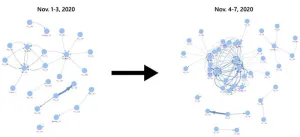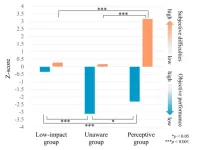Making scents of aromas that differentiate beer and wine
2024-10-29
(Press-News.org) Today, people increasingly seek non-alcoholic versions of beer or wine. Despite boasting different flavors, these two drinks share many aromas, which makes it difficult to produce alcohol-free versions that mimic the real thing. Researchers in ACS’ Journal of Agricultural and Food Chemistry report on a literature analysis and experiment to characterize the chemical compounds that give beer and wine their unique fragrances. They say their findings could aid the development of flavorful, non-alcoholic substitutes.
Food and beverage researchers are working to recreate the enjoyable aromas and flavors of beer and wine in alcohol-free substitutes. However, because both beer and wine are fermented, they have similar fragrances, and little is known about which scents evoke the unique character of each drink. So, Xingije Wang, Stephanie Frank and Martin Steinhaus set out to identify the key ingredients that distinguish the aroma of beer from that of wine.
First the team conducted a literature review and identified the average proportions of 29 compounds from beer and 32 from wine that make up the drinks’ aromas. The researchers used these proportions like recipes to concoct standard beverages that smelled like either beer or wine. From there, they tweaked these standards, swapping levels of select fragrances in the beer-like beverage to match those in the wine-like beverage, or vice versa, to test which ingredients influenced the perception of each drink. Trained taste-testers smelled each tweaked sample and evaluated it on a scale of beer-like to wine-like.
The researchers report that the taste-testers found that stronger fruity aromas made drinks smell more like wine. The team also swapped the entire profile of scented compounds from one standard into the opposite drink’s base liquid. They discovered that the scented compounds, rather than the base liquid, made the biggest difference in beer- versus wine-like aroma to the testers. The researchers say their results could be used to develop drinks that better mimic beer or wine while meeting consumers’ preferences for non-alcoholic options.
The authors acknowledge funding from the China Scholarship Council.
###
The American Chemical Society (ACS) is a nonprofit organization chartered by the U.S. Congress. ACS’ mission is to advance the broader chemistry enterprise and its practitioners for the benefit of Earth and all its people. The Society is a global leader in promoting excellence in science education and providing access to chemistry-related information and research through its multiple research solutions, peer-reviewed journals, scientific conferences, e-books and weekly news periodical Chemical & Engineering News. ACS journals are among the most cited, most trusted and most read within the scientific literature; however, ACS itself does not conduct chemical research. As a leader in scientific information solutions, its CAS division partners with global innovators to accelerate breakthroughs by curating, connecting and analyzing the world’s scientific knowledge. ACS’ main offices are in Washington, D.C., and Columbus, Ohio.
Registered journalists can subscribe to the ACS journalist news portal on EurekAlert! to access embargoed and public science press releases. For media inquiries, contact newsroom@acs.org.
Note: ACS does not conduct research but publishes and publicizes peer-reviewed scientific studies.
Follow us: X, formerly Twitter | Facebook | LinkedIn | Instagram
END
ELSE PRESS RELEASES FROM THIS DATE:
2024-10-29
Imagine harnessing the power of ocean currents to generate clean, renewable energy right off the coast of Southeast Florida. Florida Atlantic University’s Southeast National Marine Renewable Energy Center (SNMREC) has been awarded an $800,000 grant from the United States Department of Energy’s Water Power Technologies Office to enable the commercial readiness of ocean energy technologies.
SNMREC, in collaboration with a team of experts including The City of Lake Worth Beach Electric Utility, 3U Technologies, 48 North Solutions, IDOM Incorporated, Braid Theory, and the European Marine Energy Centre (EMEC), ...
2024-10-29
About this study: Plastics contain a vast number of chemicals, some of which greatly impact the environment and human health. However, information on the presence of individual substances in plastic products is oftentimes not publicly available. In a peer-reviewed study, set to be published on 29 October 2024, in Environmental Science and Technology Letters, a new publicly accessible database on chemicals measured in plastics is presented - LitChemPlast. The database contains over 3’500 substances measured in over 47'000 samples of plastic products across 372 studies.
Key findings:
• Contamination of recycled plastics:
The database shows that, due to ...
2024-10-29
Complaining about your allergies online might provide valuable data to researchers. Over 25% of Americans experience seasonal allergies, but how the prevalence of seasonal allergies varies across space and time remains obscure, in part because allergies seldom warrant visits to healthcare providers. Elias Stallard-Olivera and Noah Fierer mined Twitter (now X) posts and Google searches from 2016–2020 to extrapolate spatial and temporal allergy patterns. A natural language processing model sorted posts that indicated symptoms (e.g., “My allergies are really bad today!!”) from posts that include key words but did not indicate the presence of symptoms (e.g., “Gluten ...
2024-10-29
[11:00 GMT - 29 Oct 2024] A groundbreaking, nine-year study has revealed that elephants approaching small-scale farms in Kenya avoid beehive fences housing live honey bees up to 86% of the time during peak crop seasons, helping to reduce human-elephant conflict for local farmers and boost income. Link to images and video of the project available
Key findings include:
Beehive fences are a proven success in reducing human-elephant conflict in Africa.
Savannah elephants avoid beehive fences housing live honey bees up to 86% of the time during peak crop seasons.
Across all seasons and the entire study period, the fences deterred an annual average of 76% of 3,999 ...
2024-10-29
In the fight against antibiotic resistance, a new technology developed at Chalmers University of Technology, in Sweden, can be of great importance when, for example, hip and knee implants are surgically inserted. By heating up small nanorods of gold with near-infrared light (NIR), the bacteria are killed, and the surface of the implant becomes sterile. The researchers are now presenting a new study that increases the understanding of how the gold rods are affected by light and how the temperature in them can be measured.
Infections can occur during surgical procedures, with the risk increasing significantly when foreign materials, ...
2024-10-29
29 October 2024. Doha, Qatar – The World Innovation Summit for Health (WISH), an initiative of Qatar Foundation, has shortlisted 12 innovators for two awards within the 2024 WISH Global Healthcare Innovation Competition. Selected from more than 150 applications, the 12 will showcase their groundbreaking innovations to global policymakers and healthcare leaders at this year’s summit in Doha, 13-14 November.
In addition to the chance to receive one of two investment awards of US$10,000, shortlisted innovators will have access to mentoring sessions with industry experts to learn ...
2024-10-29
Discovery of cancer risk associations for six novel genes
Scientists at deCODE genetics/Amgen, and their collaborators have discovered six novel genes with rare germline variants that associate with cancer risk. The findings are published today in Nature Genetics under the title “Gene-based burden tests of rare germline variants identify six cancer susceptibility genes”.
A subset of cancers arises in individuals who are born with rare sequence variants that significantly alter their cancer risk. The discovery of such variants, like those in the BRCA1- and BRCA2 genes, has led to improved early cancer detection ...
2024-10-29
The unprecedented temperatures in the summer of 2022 caused more than 68,000 deaths on the continent, according to a study by the Barcelona Institute for Global Health (ISGlobal), a centre supported by the 'la Caixa' Foundation. A new study has now found that more than half - 56% - of the heat-related deaths in the summer of 2022 were related to human-induced climate change. According to the research, 38,154 of the 68,593 heat-related deaths in the summer of 2022 would not have occurred without anthropogenic warming.
The ...
2024-10-29
WASHINGTON (October 29, 2024) – A new study published today details the ways in which the 2020 U.S. election not only incited new hate content in online communities but also how it brought those communities closer together around online hate speech. The research has wider implications for better understanding how the online hate universe multiplies and hardens around local and national events such as elections, and how smaller, less regulated platforms like Telegram play a key role in that universe by creating and sustaining hate content.
The study – published in the journal npj Complexity, part of the Nature portfolio of journals – ...
2024-10-29
A research team led by Professor Takahiro Nemoto at Toho University, in collaboration with Associate Professor Naoki Hashimoto and Assistant Professor Ryo Okubo at Hokkaido University, and Dr. Satoru Ikezawa at the National Center of Neurology and Psychiatry explored the agreement or discrepancy between subjective social cognitive difficulties and actual cognitive impairment. The study aimed to identify clinical subtypes in patients with schizophrenia, the results of which were published in Springer-Nature’s journal Schizophrenia on October 29, 2024.
Key Points
In patients with schizophrenia, a decline in social cognition—a fundamental skill for interpersonal ...
LAST 30 PRESS RELEASES:
[Press-News.org] Making scents of aromas that differentiate beer and wine

